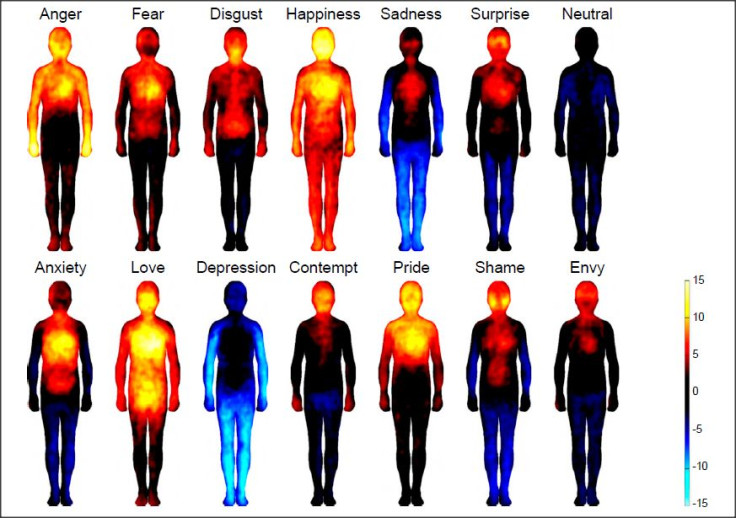What Is Our Emotional Geography? Researchers Map Bodily Sensations Commonly Identified With Feelings

Long ago, explorers sailed the seven seas and mapped the unknown world, yet over the years scientists have consistently neglected to chart the physical sensations commonly associated with different feelings. Until now. A team of researchers from Finland worked with more than 700 participants and their own specialized knowledge of emotional processing in order to create a unique geography of emotion. “Numerous studies have established that emotion systems prepare us to meet challenges encountered in the environment by adjusting the activation of the cardiovascular, skeletomuscular, neuroendocrine, and autonomic nervous system (ANS),” wrote the authors in their study, published in the Proceedings of the National Academy of Sciences journal. “This link between emotions and bodily states is also reflected in the way we speak of emotions: A young bride getting married next week may suddenly have ‘cold feet,’ severely disappointed lovers may be ‘heartbroken,’ and our favorite song may send ‘a shiver down our spine.’”
Emotional Data
In five experiments, participants from Finland, Sweden, and Taiwan were shown two silhouettes of bodies alongside emotional words, stories, movies, or facial expressions. They were asked to color the bodily regions whose activity they felt while viewing each stimulus; one silhouette was used to note areas of increased bodily sensation while the second to mark areas of decreased sensation. In order to reduce language cues, the researchers culled each story used in the experiments to weed out sensation-specific words or phrases that could potentially bias participants, such as “butterflies in the stomach,” a term often used to denote excitement. After participants had provided the necessary data, the researchers then tracked all the positive and negative responses to different emotions.
What did they discover? Throughout each investigation, all the participants consistently identified different emotions, such as happiness, contempt, and love with discrete sensations. More importantly, the maps of emotions created by individual participants showed consistency no matter whether their personal background was West European or East Asian. Though each emotion produced a unique map of physical sensation, researchers also identified areas of overlap for some emotions. For instance, some of the primal emotions, such as anger and fear, caused an increase in sensation in the upper chest area, which the researchers suspect might be tied to escalating pulse and respiration rates. In comparison, happiness increased sensation all over the body. In fact, it was the only emotion to do so.
“We conclude that emotional feelings are associated with discrete, yet partially overlapping maps of bodily sensations, which could be at the core of the emotional experience,” the authors wrote. “Unraveling the subjective bodily sensations associated with human emotions may help us to better understand mood disorders, such as depression and anxiety, which are accompanied by altered emotional processing, ANS activity, and somatosensation.” Additionally, the authors believe monitoring the topography of emotion-triggered bodily sensations might not only provide a unique research tool but also a biomarker for emotional disorders.
Source: Nummenmaa L, Glearean E, Hari R, Hietanen JK. Bodily maps of emotions. PNAS. 2013.



























